 Landscaping your backyard with shrubs and trees adds aesthetic value to your property. No-fuss plant varieties prove worthy investments, giving you years of outdoor enjoyment.
Landscaping your backyard with shrubs and trees adds aesthetic value to your property. No-fuss plant varieties prove worthy investments, giving you years of outdoor enjoyment.
Whether you hope to increase shade cover, increase privacy, or cover an eyesore, you can be sure to find the right shrubs and trees for your backyard climate. Of course, you can coordinate trees and shrubs with your landscape by selecting seasonal blooms and flower color. Plants with yellow blooms are an excellent choice, as this light and bright color can add vivid contrast to an all green background.
Check out our list of yellow flowing ornamental trees and shrubs for ideas on how to improve your backyard landscape.
Shrubs
Shrubs are fantastic for bordering your backyard, to increase your privacy or provide a lush backdrop amid other landscaping. Our list of yellow flowering, perennial shrubs are low-maintenance plants with high aesthetic value.
1. Forsythia
You might hear forsythia suspensa referred to as an “Easter tree” because it bursts with vibrant, yellow blossoms before its leaves emerge during early spring. This woody, unruly hedge flourishes throughout Northeastern USA, but all 11 species are native to Eastern Asia.

Growing Tips:
- Full to partial sun.
- Permeable soil with pH 6.5 to 7.5.
- USDA Plant Hardiness Zones 5 - 11.
Choose your location for forsythia wisely because this perennial grows quickly, roughly 24-inches per year. Fully grown forsythia is 10-feet tall and 10 to 12 feet wide. Tame forsythia by pruning immediately after flowering.
2. Roses
Classic flowering shrubs, roses, or rosa are rugged beauties that grow between 3-feet and 10-feet tall. Among 300 species of roses, several varieties produce luxurious, yellow blooms to adorn woody, thorny stems. Perennial shrub roses repeatedly bloom during the growing season.
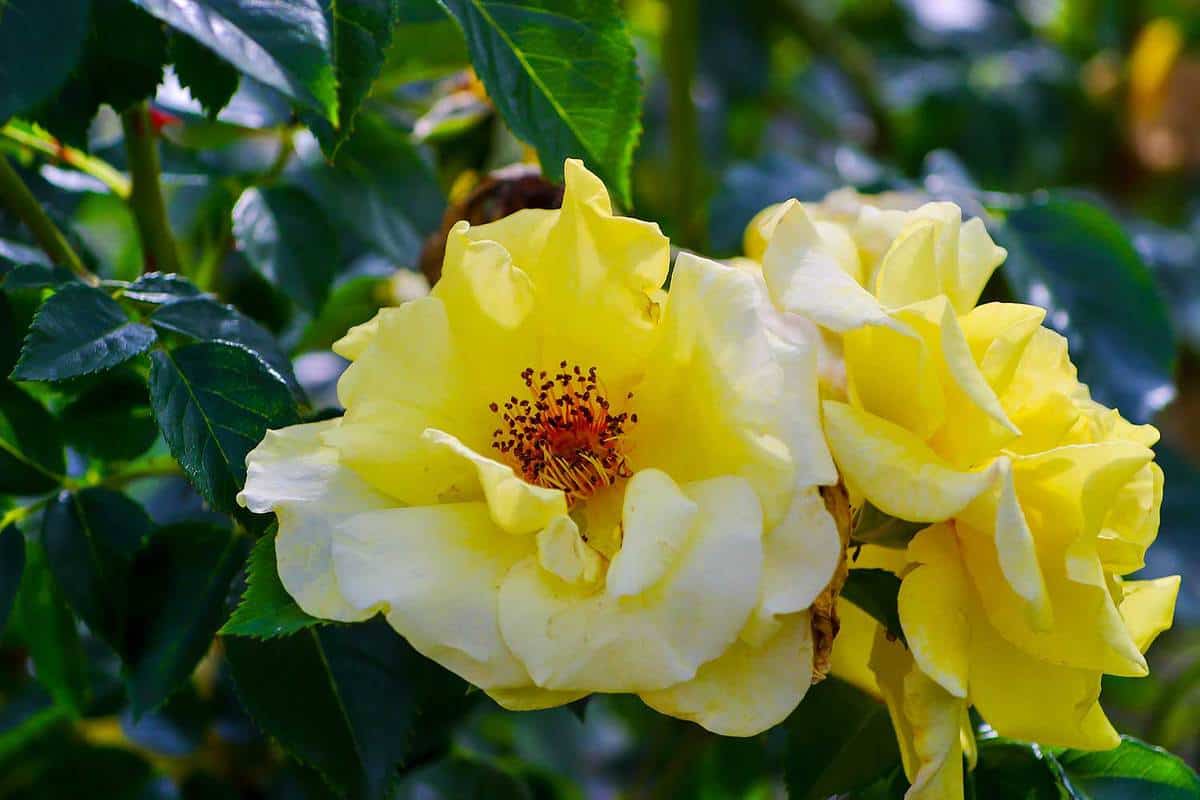
Growing Tips:
- Full sun.
- Permeable, moist soil.
- USDA Plant Hardiness Zones 3 - 10.
Prune roses during early spring for the desired shape. Fertilizing will stimulate bloom production.
3. Witch Hazel
Fully grown, witch hazel or hamaelis virginiana is more a small tree than a shrub reaching a height of 30-feet and width of 15-feet. Witch hazel is a slow-growing plant, so it will provide you joy while reaching maturity within 20-years. Fiery, yellow-orange ribbon-like blossoms explode during the dark winter season for a burst of color in your backyard.
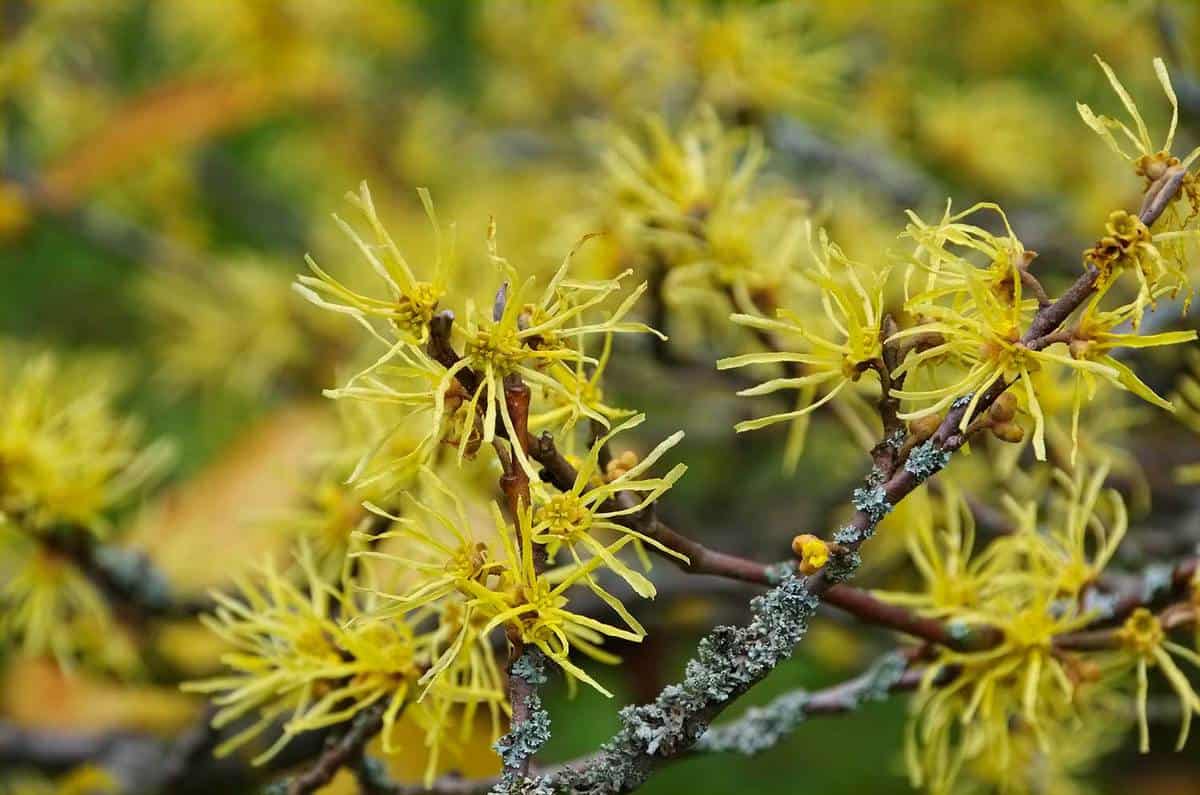
Growing Tips:
- Full sun to partial shade.
- Permeable, moist soil.
- USDA Plant Hardiness Zones 3 - 9.
Prune witch hazel just before the summer season, after winter flowers are spent. Witch hazel is extremely fragrant.
4. Bush Cinquefoil
Bush cinquefoil or potentilla fruiticosa is an overhanging, dwarf shrub that grows between 2 to 4 feet tall and 3 to 5 feet wide. Blue-green leaves accentuate petite, yellow blossoms. The flowers each have five petals, hence “cinquefoil.” The shrub goes by several other names, including yellow rose, five-fingers, and golden hardhack.
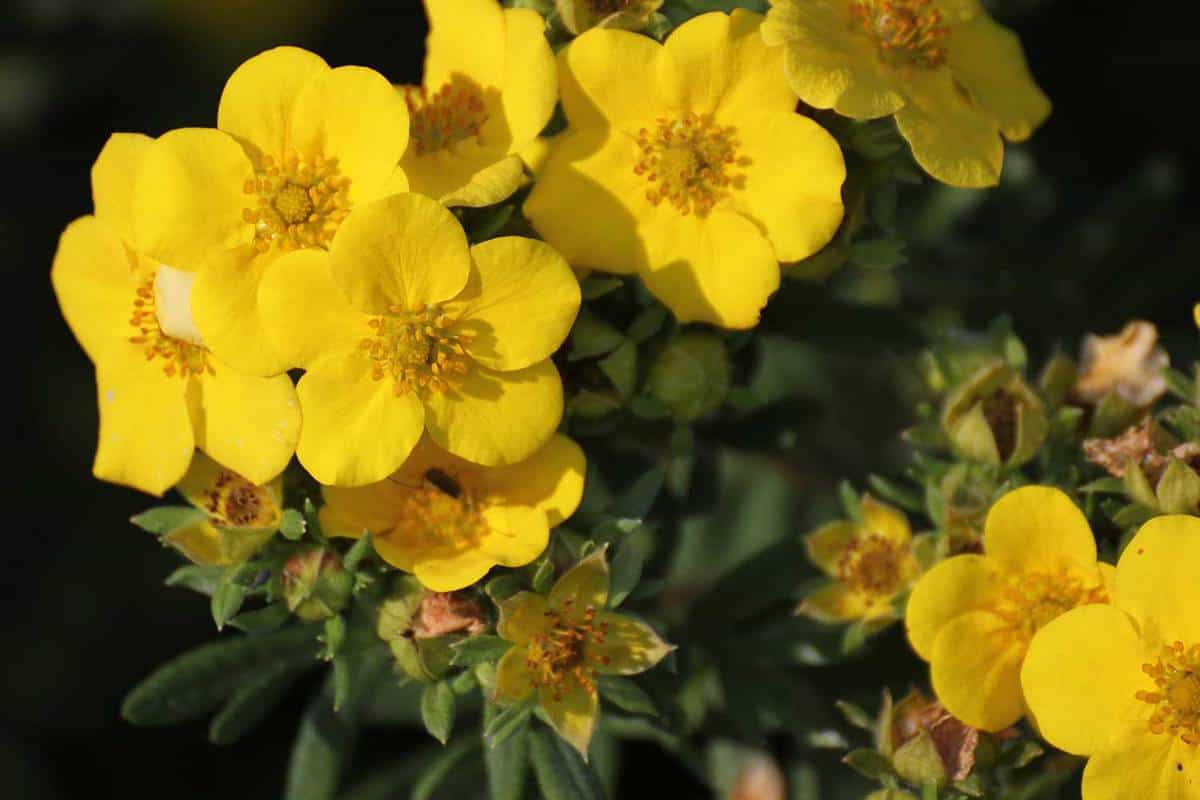
Growing Tips:
- Full sun to partial shade.
- Loamy, moist soil with a pH between 5 and 7.
- USDA Plant Hardiness Zones 3 - 7.
Prune as needed during winter months. During the growing season, bush cinquefoil attracts butterflies to your backyard. It is drought tolerant and resistant to deer.
5. Azalea
Among numerous varieties of azalea or rhododendron, you will find both evergreen and deciduous plants. Tall varieties can grow over 20-feet high, but common garden azaleas stay within 4 to 6 feet. Bright blooms pop amid light green leaves, with hues of either yellow or white, pink, red, orange, and purple.

Growing Tips:
- Shade to partial sun.
- Permeable, moist soil with a pH between 4.5 and 6.
- USDA Plant Hardiness Zones 4 - 6.
Prune azaleas immediately after flowering. You can choose from early, mid -, and late-flowering varieties so your azaleas can paint the landscape throughout the spring, summer, and autumn seasons.
6. Japanese Rose
The overarching branches of a Japanese rose or kerria japonica give this deciduous shrub an airy appearance. Green-yellow stems retain their brilliant color throughout the winter season. Yellow, wavy blooms radiate during early spring.
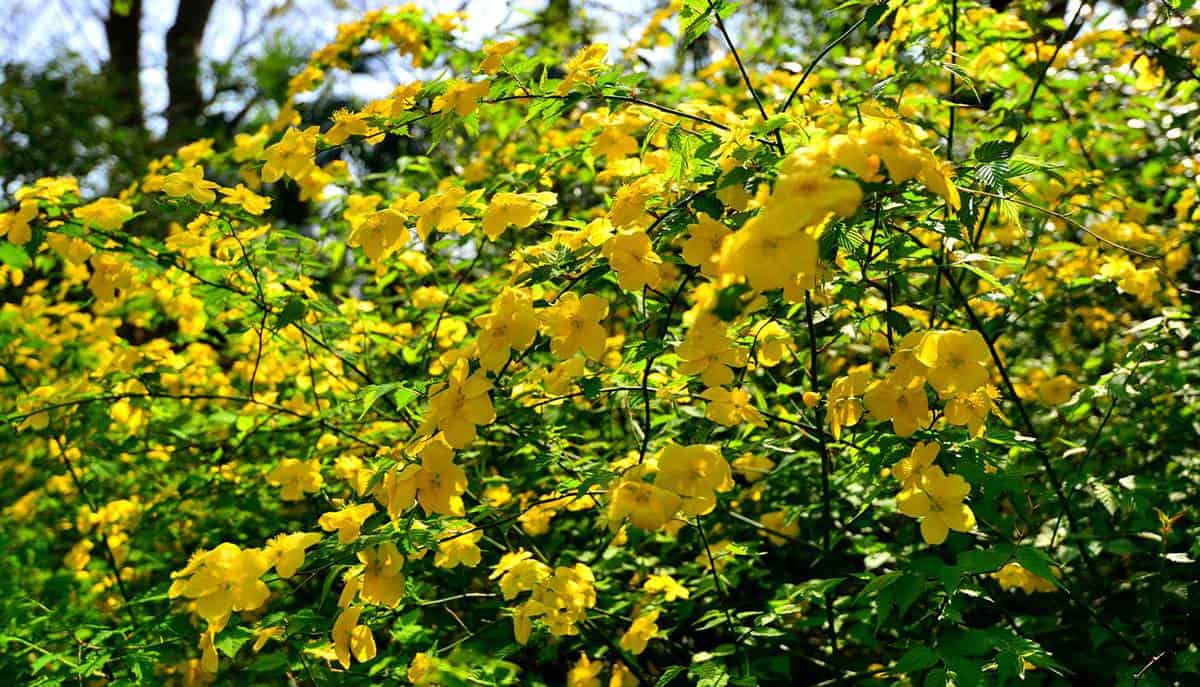
Growing Tips:
- Partial shade.
- Loamy soil.
- USDA Plant Hardiness Zones 4 - 9.
Prune immediately after flowering. Although it looks delicate, the Japanese rose deters deer.
7. Mahonia
An evergreen shrub with leaves resembling holly, mahonia has several species belonging to the berberidaceae family. M. aquifolium produces yellow flowers during spring and clusters of navy berries during summer. It grows between 3-feet and 8-feet tall, as a dense shrub good for privacy and concealing backyard eyesores.
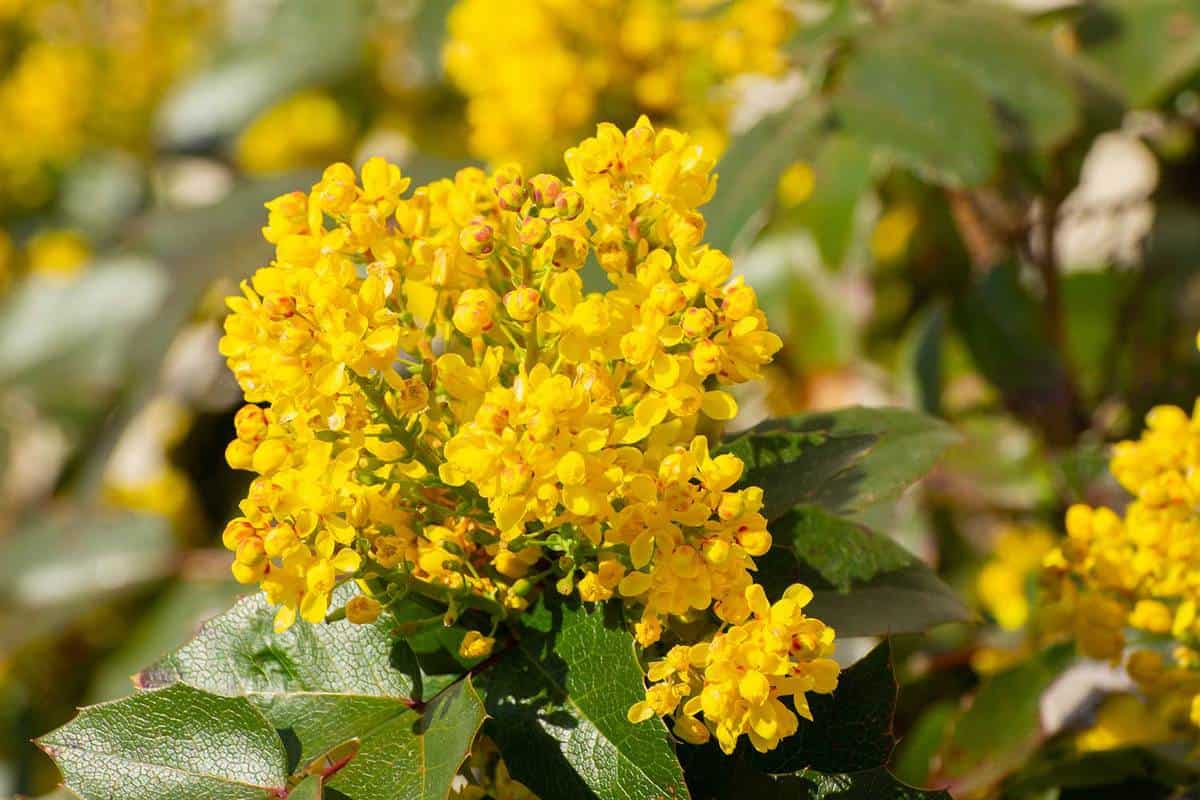
Growing Tips:
- Partial shade.
- Permeable, moist soil.
- USDA Plant Hardiness Zones 5 - 9.
The berries of mahonia are edible, although tart. Mahonia’s spiny foliage deters deer.
8. Potentilla
We’ve mentioned potentilla fruiticosa or bush cinquefoil, but there are several other varieties of this ornamental shrub. If you prefer a yellow blossom, you might consider “sunset” potentilla with bold, orange flowers that fade yellower as the summer progresses. “Primrose beauty” potentilla features grey-green leaves and pale yellow flowers.
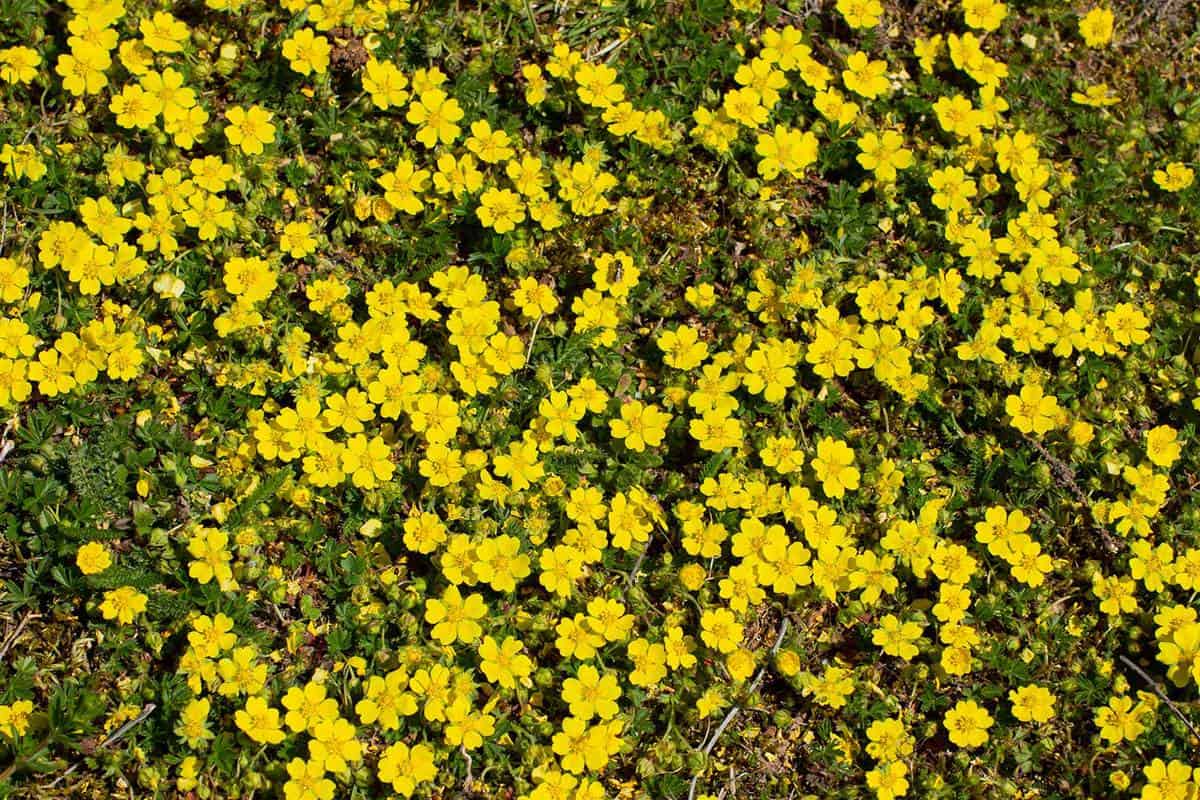
Growing Tips:
- Full sun to partial shade.
- Loamy, moist soil with a pH between 5 and 7.
- USDA Plant Hardiness Zones 3 - 7.
All varieties will attract butterflies to your backyard, and resist deer.
9. Lydian Broom
Lydian broom or genista Lydia is a low maintenance shrub with broad ground cover, growing 2-feet tall and 3-feet wide. Flowering shoots emerge each spring, and the bush is swept by brilliant yellow, pea-shaped blooms. In warmer climates, Lydian broom stays evergreen displaying dainty, green-blue leaves throughout the year.
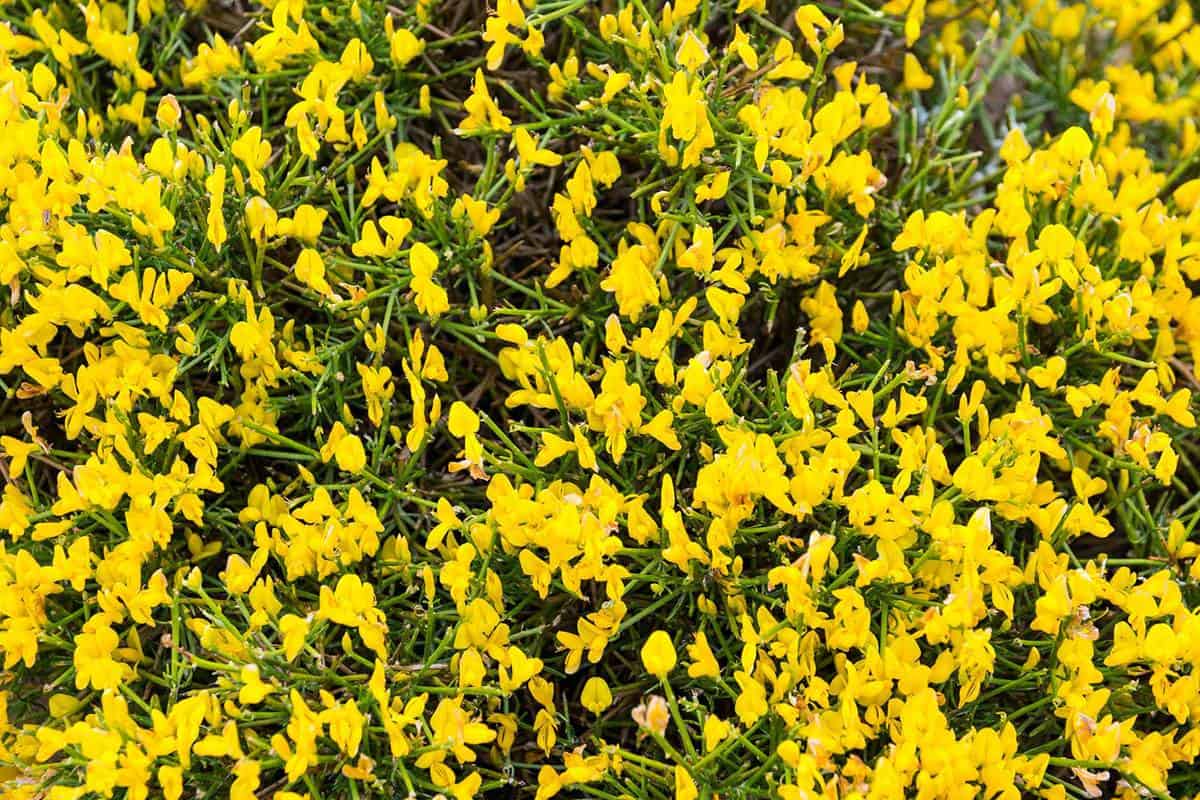
Growing Tips:
- Full sun.
- Permeable, moist soil.
- USDA Plant Hardiness Zones 6 - 9.
Prune after flowering, by trimming young branches and allowing old wood to remain. Lydian broom is a lovely addition to rock gardens and sloped gardens to prevent erosion.
10. St. John’s Wort
St. John’s Wort or hypericum perforatum is an easy to grow ornamental shrub. St. John’s wort varieties range in size between 3-feet and 9-feet tall and 5-feet wide. Lovely, yellow blossoms feature showy, elongated stamens. St. John’s wort also produces eye-catching berries ranging in hue from red to pink.
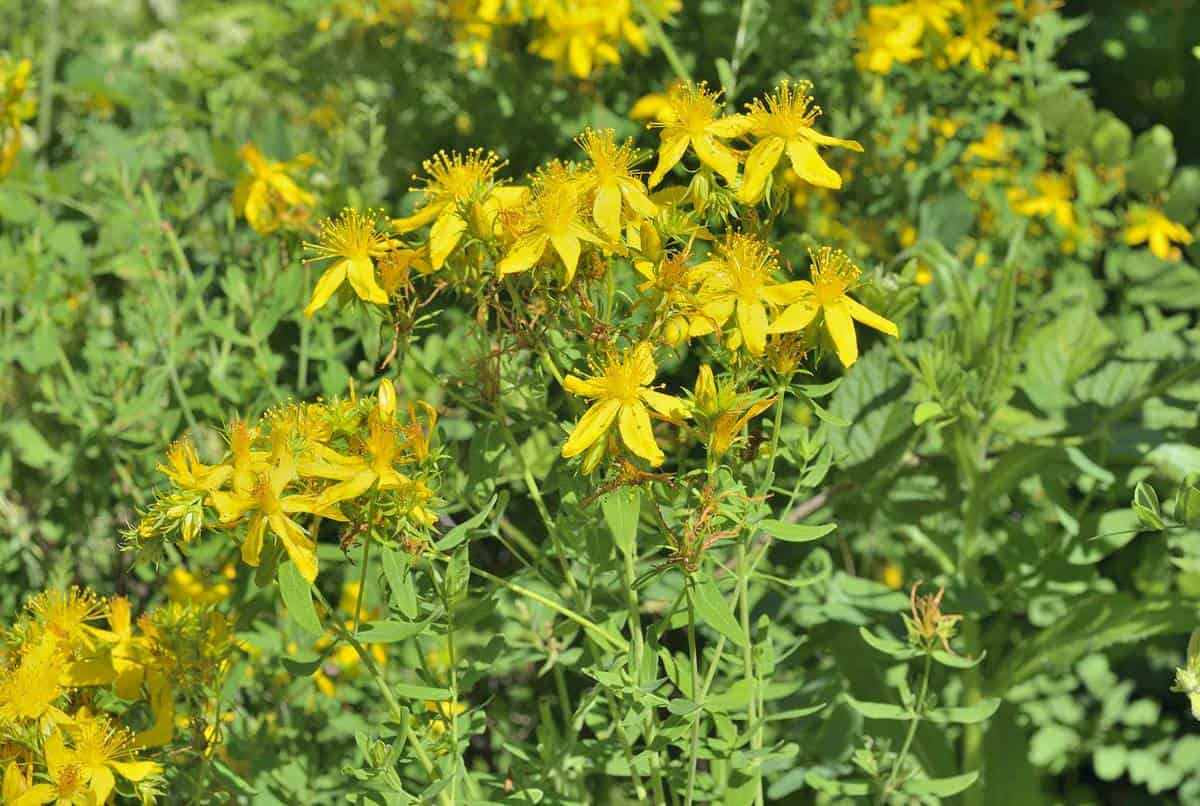
Growing Tips:
- Full sun to partial shade.
- Loamy soil.
- USDA Plant Hardiness Zones 3 - 8.
Pruning St. John’s wort will increase flowering because blossoms emerge on new growth. Trim the shrub during early spring, by removing dead and damaged branches.
11. Yellow Camellia Shrub
Camellia is a woody shrub with delicate, somewhat peony-like blooms. Both c. sasanqua, and c. japonia varieties are evergreen, ideal for ornamental landscaping because both feature shiny, dark green foliage year ‘round.
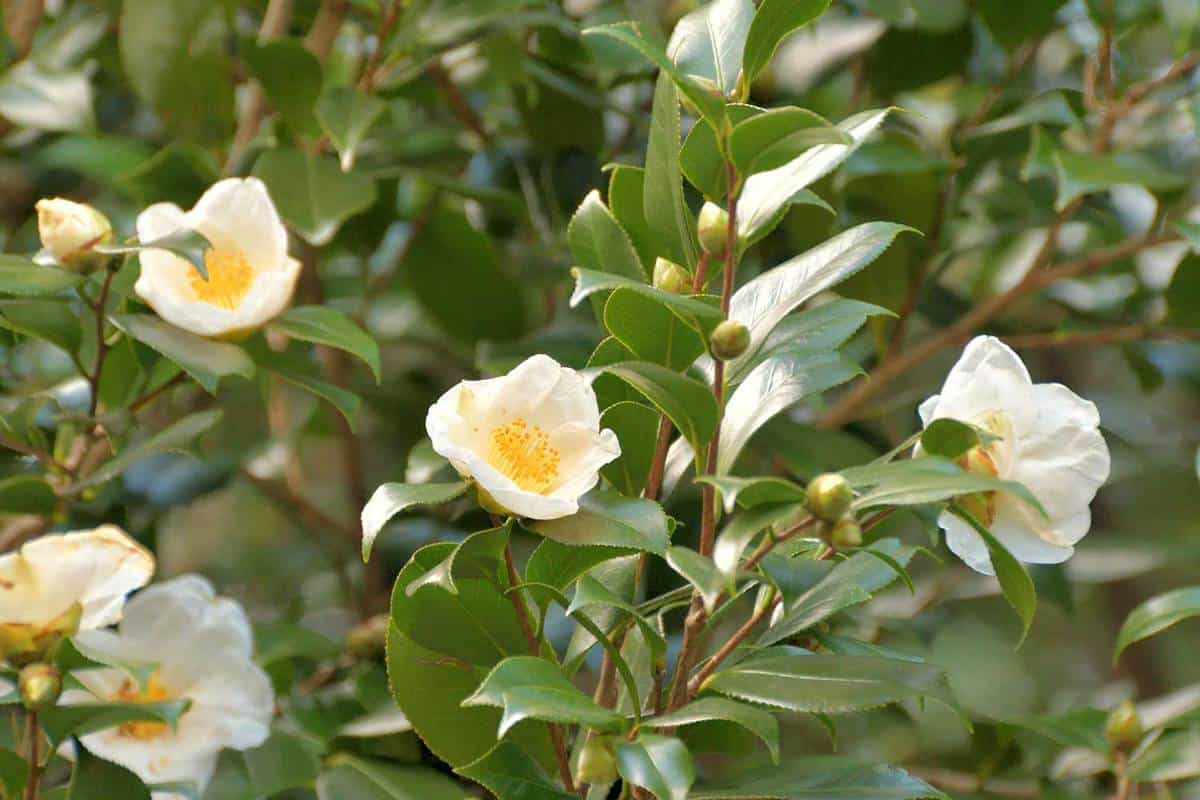
Growing Tips:
- Partial shade.
- Permeable soil with a pH between 5.5 and 6.8.
- USDA Plant Hardiness Zones
Prune either during winter or early spring. Camellia varieties are slow-growing, and reach heights between 2-feet and upwards of 12-feet over many years provided ideal growing conditions.
Trees
Adding trees to your landscape not only makes a house feel more like home, but trees provide shade and encourage wildlife. Our list of yellow flowering trees will delight you with a burst of seasonal color.
1. Tipu
The tipuana tipu deciduous tree, native to South America, is a striking shade tree ideal for warmer climates. Quickly growing at 2 to 3 feet annually, tipu trees reach between 25-feet and 50-feet. The tipu tree comes aglow during summertime with golden-yellow blossoms. Pea-like seed pods dangle during spring through mid-summer. Dropped annually along with helicopter shaped leaves the pods do require some yard cleanup.
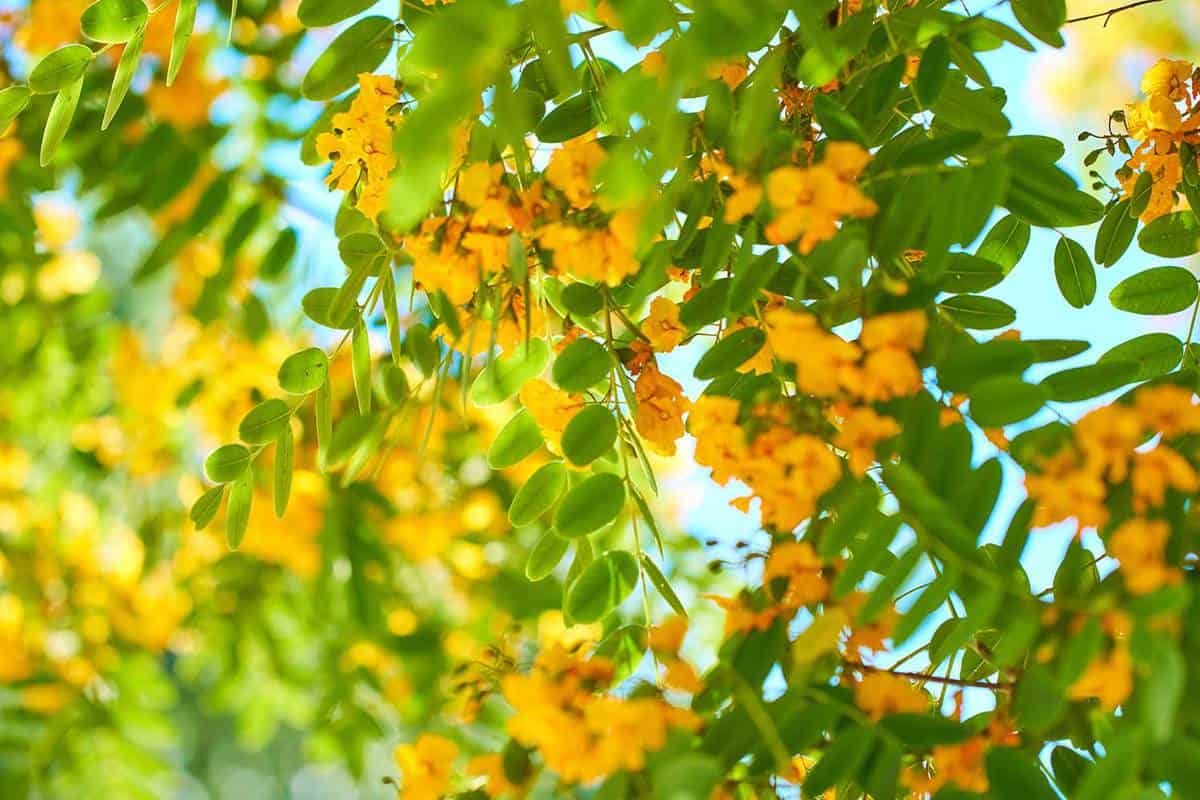
Growing Tips:
- Full sun.
- Loamy soil.
- USDA Plant Hardiness Zones 9 - 11.
Tipu trees live between 50 and 100 years. They are relatively tolerant of drought and salty coastal conditions.
2. Palo Verde
There are four species and one hybrid, of the palo verde or parkinsonia acuelata that are all native to Southwestern USA. Incredibly drought resistant, the palo verde has a green trunk that is capable of photosynthesis to protect the tree when dry conditions prohibit foliage. Palo verde varieties grow between 20-feet and 35-feet tall. Vibrant yellow clusters of springtime blossoms adorn the canopy of this shade cover tree.
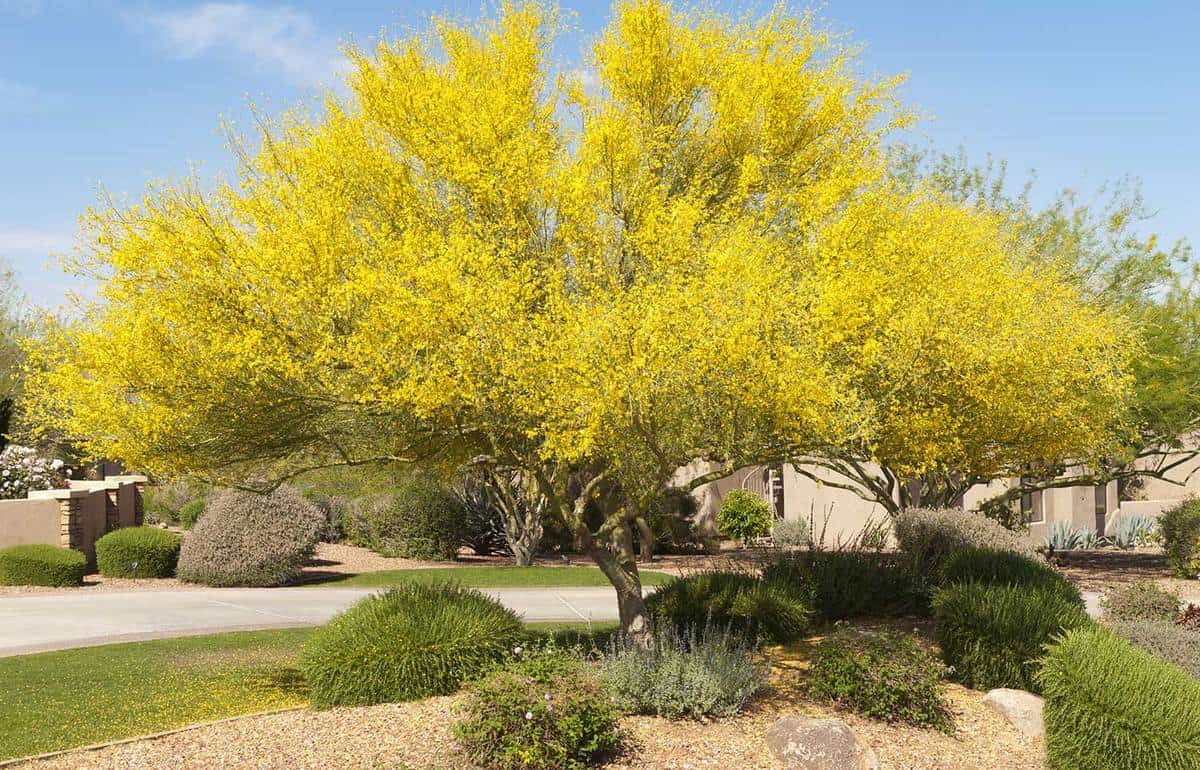
Growing Tips:
- Full sun.
- Sandy to loamy soil.
- USDA Plant Hardiness Zones 8 - 11.
Be cautious if you plan to locate palo verde near busy walkways because the branches are armed with sharp thorns. Some cleanup is necessary for fallen seed pods, roughly 2 to 6 inches long.
3. Yellow Chain Tree
The laburnum tree, commonly called yellow or golden chain tree, is an ornamental delight during late spring when brilliant yellow blossoms dangle from nearly 2-foot long bunches. Clusters of bright green leaves remain after flowering, and seed pods develop. Quickly growing golden chain trees become between 15-feet and 30-feet tall.
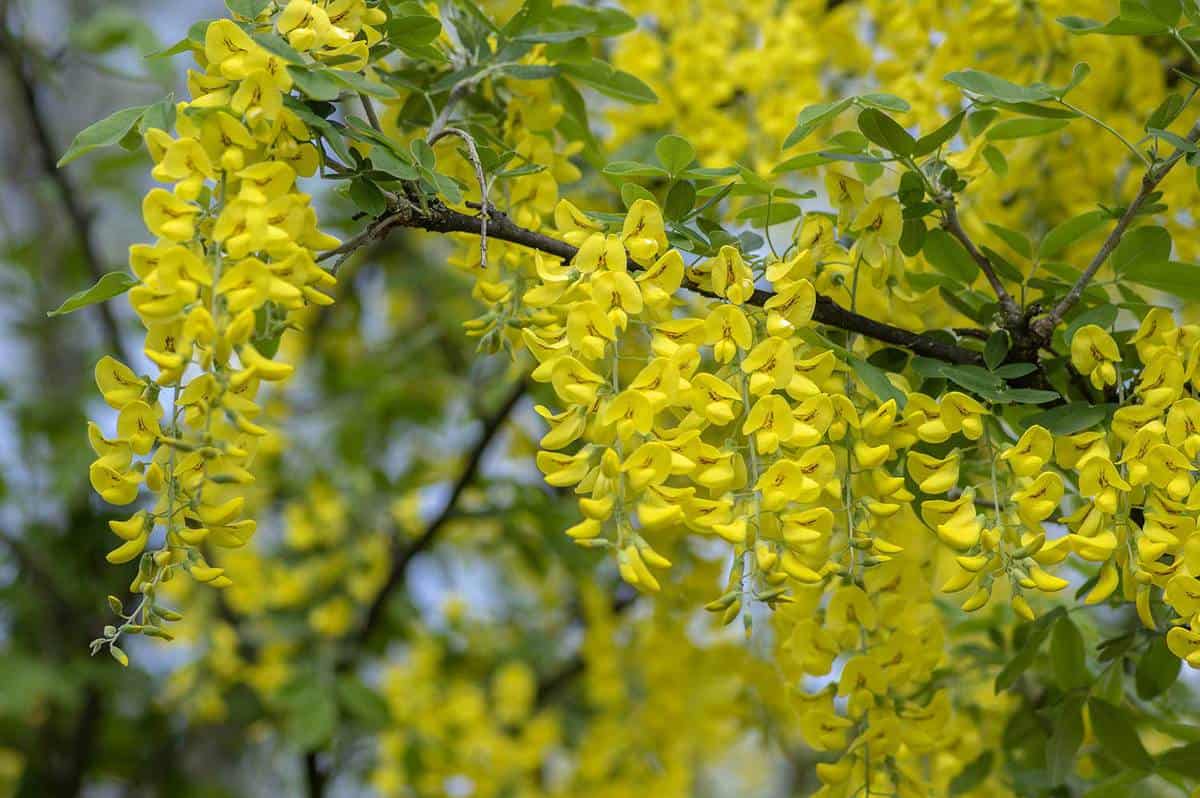
Growing Tips:
- Full sun to partial shade.
- Permeable soil.
- USDA Plant Hardiness Zones 5 - 7.
Important to note, particularly if you have young children or pets enjoying your backyard, that all parts of the golden chain tree are toxic and can prove fatal if large quantities are ingested.
4. Golden Shower Tree
The golden shower tree or cassia fistula is lovely in full bloom, with cascading, 1-foot long yellow flower clusters emerging during early spring. Fully grown golden shower trees reach heights of 40-feet. Dark brown, legume-like seed pods follow the flowering to remain on the tree until wintertime.
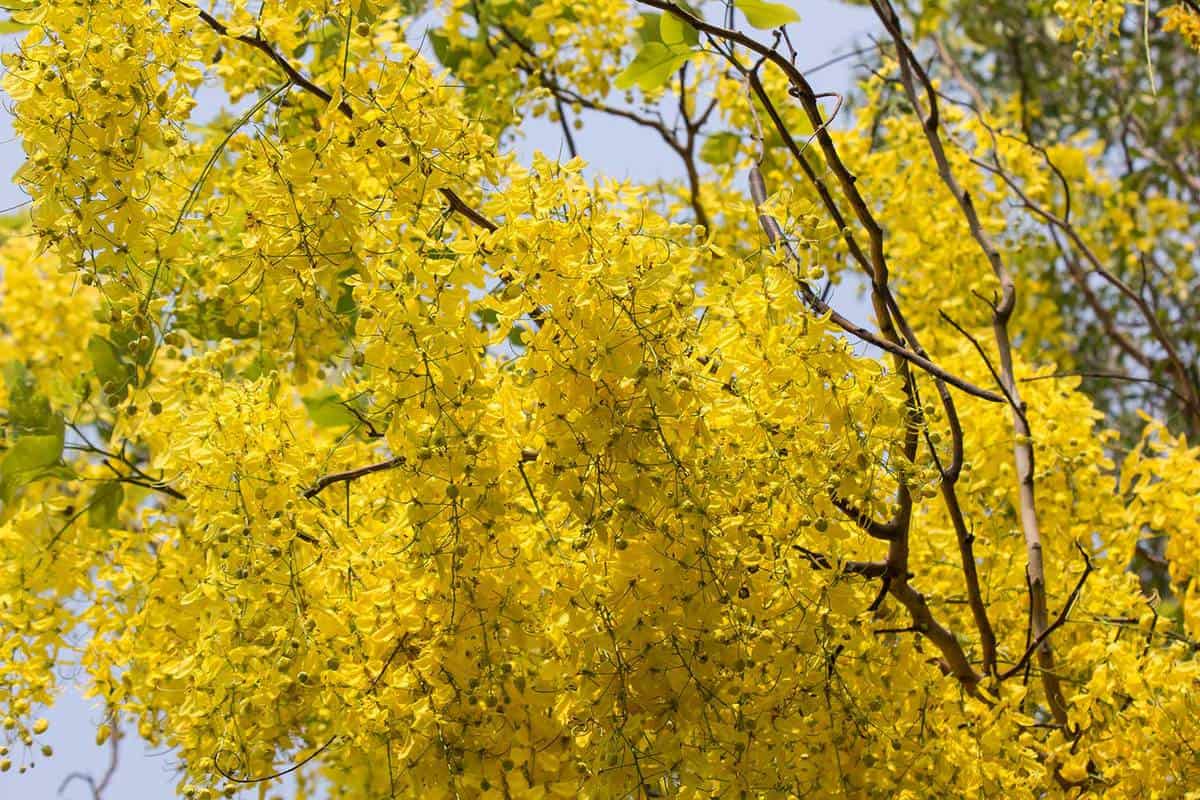
Growing Tips:
- Full sun.
- Permeable soil.
- USDA Plant Hardiness Zones 10 - 11.
Young trees must be pruned and sometimes staked, to promote upward growth because branches are prone to grow asymmetrically. The seeds of golden shower trees are toxic.
5. Chinese Flame Tree
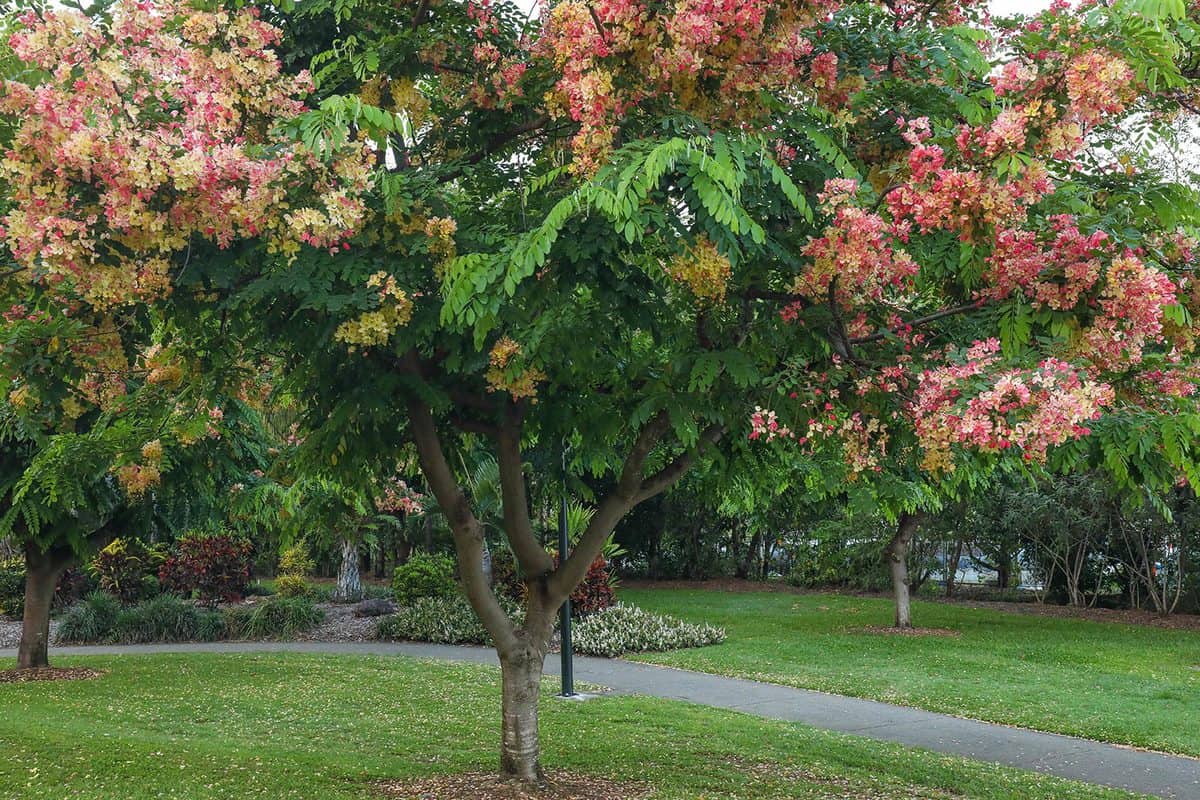
Growing between 25-feet and 45-feet tall, the Chinese flame tree or koelreuteria bipinnata puts on a late-summertime, colorful display of foliage, flowers, and seeds. Small yellow blossoms spring out atop the green canopy, to then be replaced with puffy, paper-like seed pods. The showy seed pods vary in color from orange, red, and salmon seemingly float above the canopy.
Growing Tips:
- Full sun.
- Loamy soil.
- USDA Plant Hardiness Zones 7 - 9.
Chinese flame trees are popular shade trees for landscapes. Prune mature trees by continually removing lower branches, and any additional trunk attempting to grow at the base.
6. Golden Trumpet
The golden trumpet tree or handroanthus chrysotrichus sounds its own horn when glorifying yellow trumpet-shaped flowers emerge just before springtime. The abundant floral aroma reminds us that summer is approaching. Seed pods dangle from late-summer through winter. Smaller golden trumpet tree varieties, typically 30 to 40 feet tall, are cultivated for landscaping with white, pink, red, or purple blooms also available.
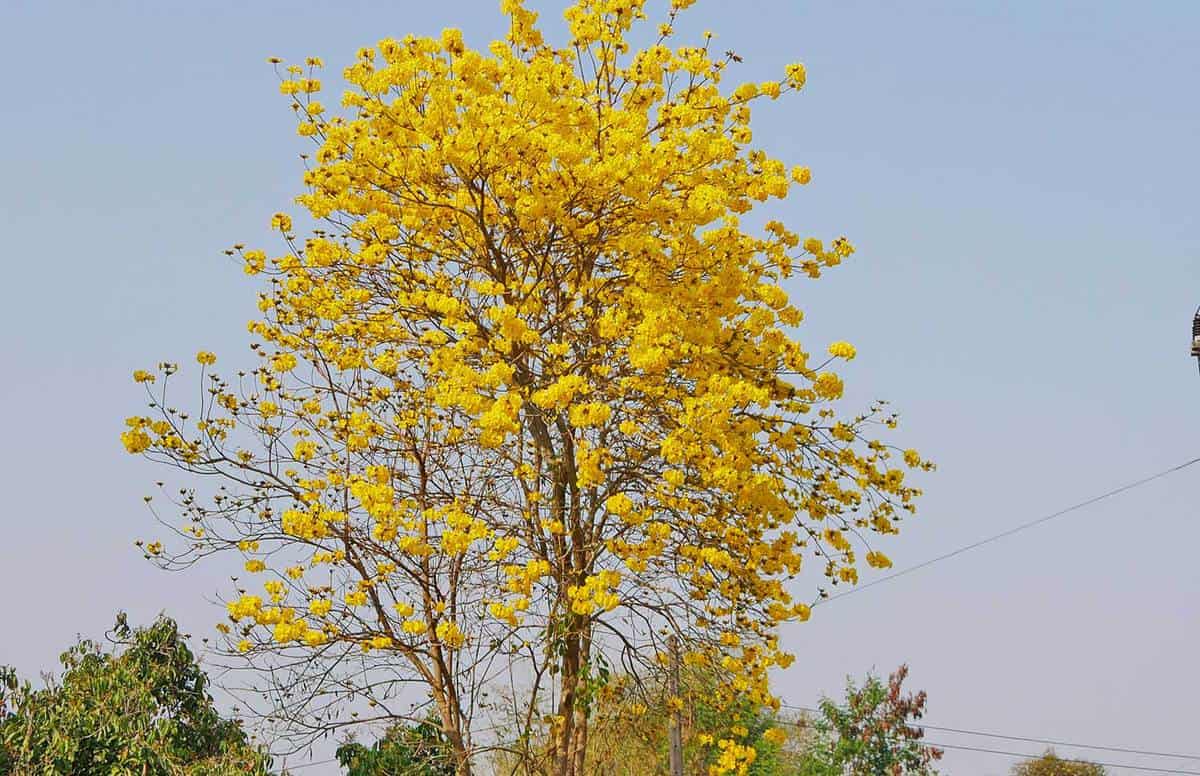
Growing Tips:
- Full sun.
- Sandy to loamy soil.
- USDA Plant Hardiness Zones 9 - 11.
Tubular, golden trumpet flowers can grow as large as 4-inches wide in diameter. Pruning old stems helps the tree to thrive.
7. Yellow Buckeye
The deciduous yellow buckeye tree or aesculus flava produces perky, 6-inch tall yellow flowers during spring and striking yellow-orange autumn foliage. Broad green leaves provide a backdrop for this seasonally diverse tree that grows between 60 to 75 feet tall.
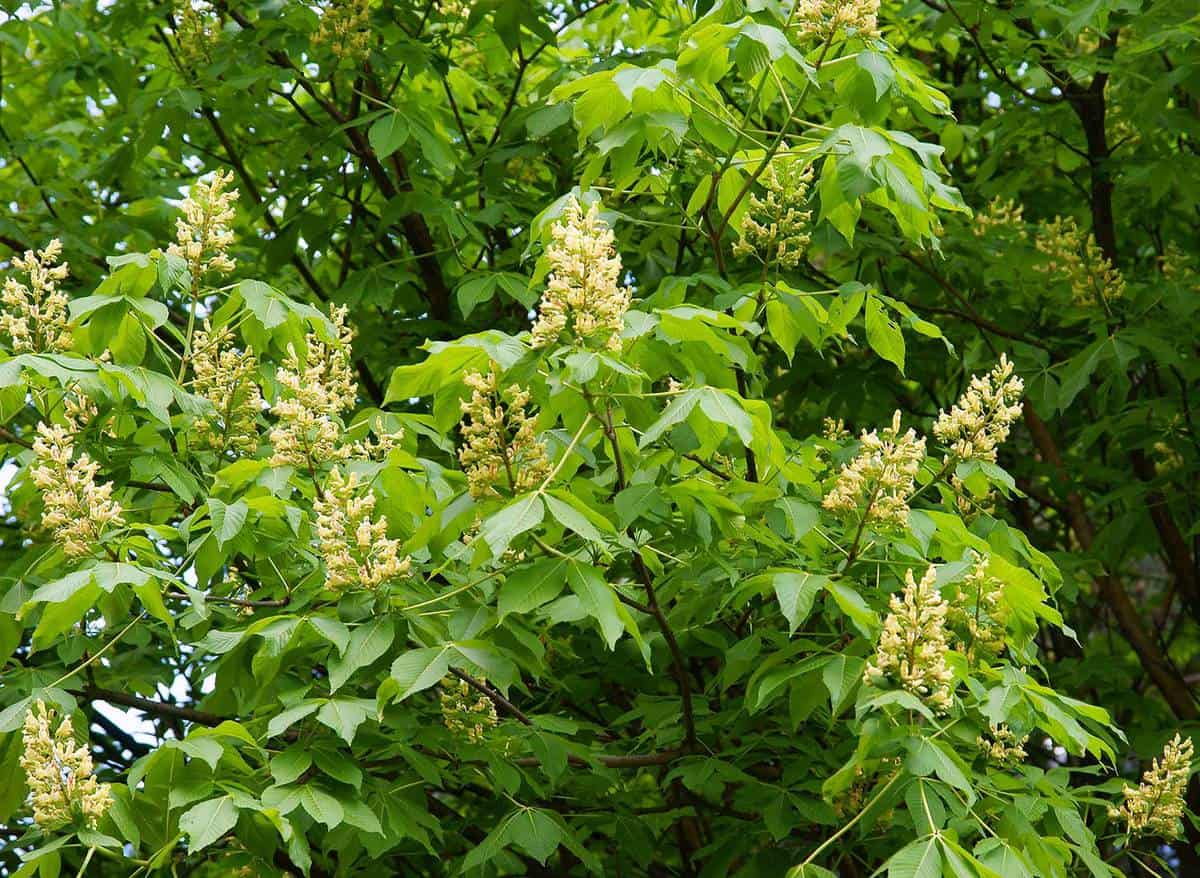
Growing Tips:
- Full sun.
- Loamy soil.
- USDA Plant Hardiness Zones 4 - 8.
The common name “buckeye” stems from the appearance shiny, dark seeds with a dull, white area that resemble a deer’s eye.
8. Thevetia
Thevetia peruviana is commonly referred to as yellow oleander. This small, between 6-feet to 12-feet tall evergreen tree has bright green, glossy foliage. Summertime blooms are vibrant yellow, funnel-shaped flowers. After flowering, yellow oleander produces black seed pods that can be prevented if spent flowers are trimmed immediately.
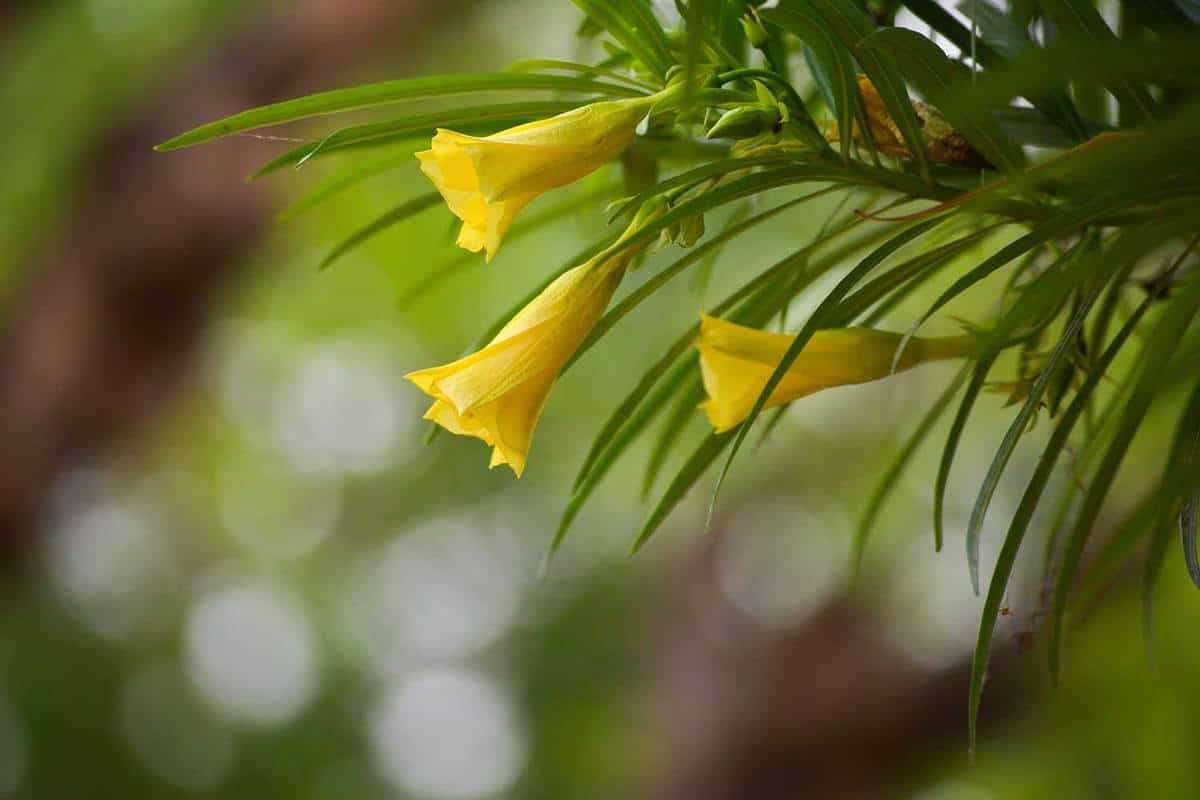
Growing Tips:
- Full sun.
- Sandy to loamy soil.
- USDA Plant Hardiness Zones 9 - 11.
Prune yellow oleander after flowering. Note that all parts of the yellow oleander are toxic, and the tree’s milky sap can cause skin irritation.
9. Sweet Acacia
An autumn bloomer, acacia farnesiana, or sweet acacia produces puffy, golden flowers. When the sweet fragrance and blossoms subside, dark brown seed pods emerge. Sweet acacia trees grow up to 20-feet tall with a widespread canopy.
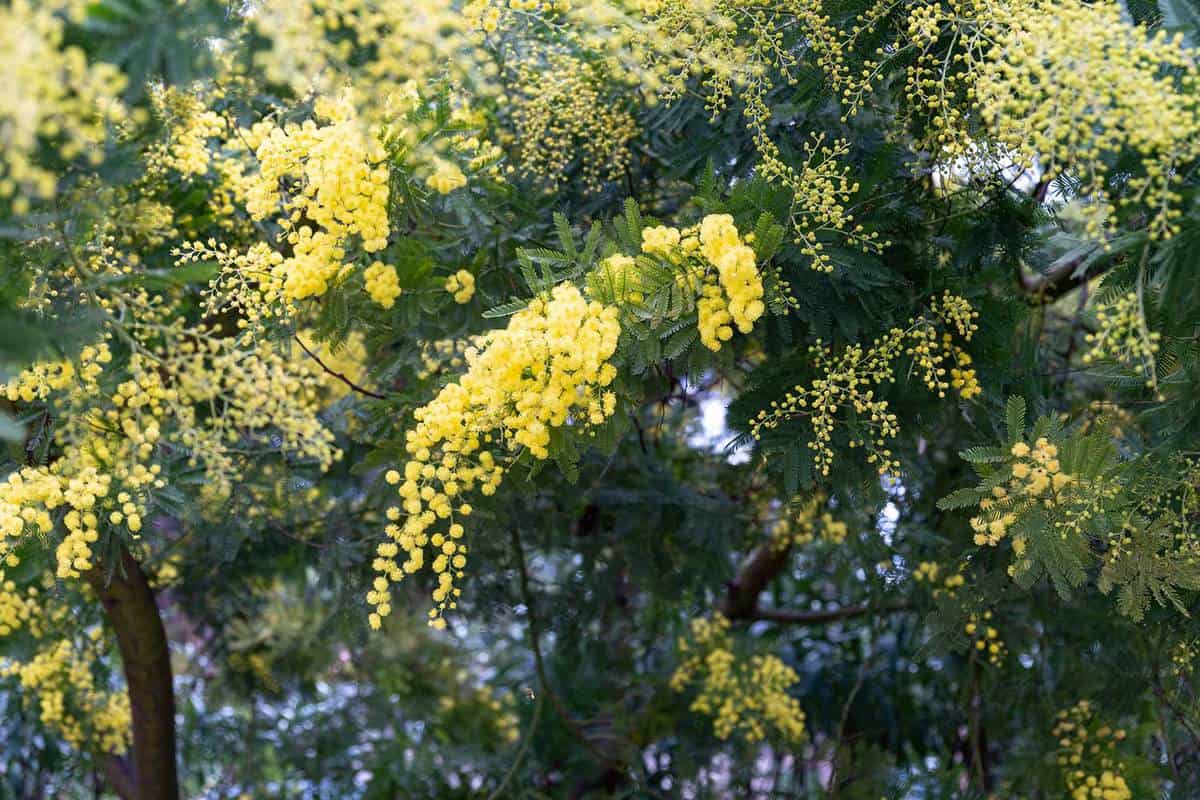
Growing Tips:
- Full sun.
- Permeable soil.
- USDA Plant Hardiness Zones 9 - 11.
Take care in selecting acacia trees because some variations have thorns amid their deceptively soft blooms.
10. Palo Brea
Palo Brea or parkinsonia praecox grows between 20 to 25 feet tall with an interwoven canopy of distinctive, green bark branches. Appearing semi-evergreen, the bark of Palo Brea is capable of photosynthesis for a drought-tolerant tree. Radiant yellow blossoms come ablaze during mid-spring, followed by brown seed pods.
Growing Tips:
- Full sun.
- Permeable soil.
- USDA Plant Hardiness Zones 9 - 11.
An unruly looking tree, Palo Brea is recommenced to incorporate onto on open, arid landscapes.
If you are looking for more landscaping ideas, check out our blogs:
